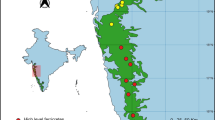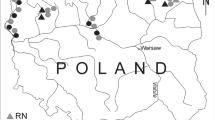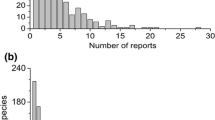Abstract
It is generally accepted belief that serpentine areas are inhabited by a smaller number of species than known from other types of geological substrates. Based on this idea we selected, as a model system, the area of the northwestern Serbia and Šumadija with well represented serpentinite, carbonate and silicate rocks, in order to evaluate the influence of a different geology and habitat types on the differentiation of the analyzed floras and determine whether the serpentinites are really inhabited by a smaller number of species than other types of geological substrate. Based on the results of several statistical analyses of the investigated area, we found that: i) serpentinites are inhabited by a smaller number of species compared to carbonate, but a higher number of species compared to silicate geological substrate, ii) the particular habitat types on serpentinites exhibit greater floristic diversity than the equivalent habitat types on other geological substrates, iii) similarity within the same habitat type of serpentinite, carbonate and silicate floras is greater than the similarity between the different serpentine floras of the different habitat types, iv) environmental factors such as moisture and habitat type have a larger impact on the differentiation of the flora, compared to the type of geological substrate, and v) the largest number of serpentinophytes were registered in the xerophilous forests and xerophilous grasslands compared to other habitat types.
Similar content being viewed by others
References
Alexander E.B. 1988. Morphology, fertility and classification of productive soils on serpentinized peridotites in California (U.S.A.). Geoderma 41: 337–351.
Alexander B. 2011. Serpentine soils and why they limit plant survival and growth. Fremontia 38(4)–39(1): 28–31.
Alexander E.B., Coleman R.G., Keeler-Wolf T. & Harrison S. 2007. Serpentine Geoecology of Western North America. Oxford University Press, New York, 512 pp.
D’Amico M.E. & Previtali F. 2012. edaphic influences of ophiolitic substrates on vegetation in the Western Italian Alps. Plant Soil 351(1–2): 73–95.
Anđelković M. 1982. Geologija Jugoslavije. Tektonika. Univerzitet u Beogradu, Rudarsko-geološki fakultet, OOUR za regioanalnu geologiju i paleontologiju, Beograd, 692 pp.
Brooks R.R. 1987. Serpentine and its vegetation. A Multidisciplinary Approach. Dioscorides Press, Portland, 454 pp.
Brković T., Radovanović Z. & Pavlović Z. 1980. Socijalistička Federativna Republika Jugoslavija. Osnovna geološka karta 1:100000. L34-138 Kragujevac. Savezni geološki zavod, Beograd.
Chapman A.D. 2005a. Principles and Methods of Data Cleaning–Primary Species and Species-Occurrence Data, version 1.0. Report for the Global Biodiversity Information Facility, Copenhagen, Available online at http://www.gbif.org/orc/?docid=1262.
Chapman A.D. 2005b. Principles of Data Quality, version 1.0. Report for the Global Biodiversity Information Facility, Copenhagen, 58 pp.
Constantinidis Th. 2004. The floristic Diversity of Serpentine in Greece 1. An Inventory of the Aliki Area (Sterea Ellas, Central Greece). Phyton 44: 45–67.
Cottle R. 2004. Linking Geology and Biodiversity. English Nature, Peterborough (Research Report 562), 91 pp.
Ehlers E.G. & Blatt H. 1982. Petrology: Igneous, Sedimentary and Metamorphic. W.H. Freeman and Company, San Francisco, 732 pp.
Filipović I., Pavlović Z., Marković B., Rodin V., Marković O., Gagić N., Atin B. & Milićević M. 1978. Socijalistička Federativna Republika Jugoslavija. Osnovna geološka karta 1:100000. L34–137 Gornji Milanovac. Savezni geološki zavod, Beograd.
Glišić O. & Stevanović B. 1996a. Adaptivne karakteristike vrste Artemisia alba Turra (Asteraceae) sa serpentinita. Ekologija 31: 87–96.
Glišić O. & Stevanović B. 1996b. Strukturne adaptacije balkanskih endemičnih serpentinofita roda Potentilla L. (Rosaceae). Glas. Inst. bot. i bašte univ. u Beogradu 30: 59–70.
Ghaderian M.S. & Baker A.J.M. 2007. Geobotanical and biogeochemical reconnaissance of the ultramafics of Central Iran. J. Geochem. Explor. 92: 34–42.
Hammer Ø. 2012. PAST–Paleontological Statistics, Version 2.17. Natural History Museum, University of Oslo, Oslo.
Horvat I., Glavač V. & Ellenberg H. 1974. Vegetation Südosteuropas. Geobotanica selecta 4. Gustav Fischer Verlag, Stuttgart, 768 pp.
Horvatić S. 1967. Fitogeografske značajke i raščlanjenje Jugoslavije 1(1), 23–61. In: Horvatić S. (ed.), Flora Analytica Jugoslaviae. Institut za botaniku Sveučilišta u Zagrebu, Zagreb.
Jenny H. 1980. The soil resource: Origin and behaviour. Ecological Studies Vol. 37, Springer-Verlag, New York, 377 pp.
Karadžić B., Šašo-Jovanović V., Jovanović Z. & Popović R. 1998: FLORA–a database and software for floristic and vegetation analyzes, pp. 69–72. In: Tsekos I. & Moustakas M. (eds), Progress in botanical research. Kluwer Academic Publishers, Dodrecht.
Karataglis S., Babalonas D. & Kabasakalis B. 1982. The ecology of plant populations growing on serpentine soils. Phyton 22: 317–327.
Kliment J., Šibíková I. & Šibík J. 2011. On the occurrence of the arctic-alpine and endemic species in the high-altitude vegetation of the Western Carpathians. Thaiszia J. Bot. 21: 45–61.
Kliment J., Šibík J., Šibíková I., Jarolímek I., Dúbravcová Z. & Uhlířová J. 2010. High-altitude vegetation of the Western Carpathians–a syntaxonomical review. Biologia 65: 965–989.
Kruckenberg A.R. 1951. Intraspecific variability in the response of certain native plant species to serpentine soil. Amer. J. Bot. 38: 408–419.
Kruckeberg A.R. 1954. The ecology of serpentine soils: A symposium. III. Plant species in relation to serpentine soils. Ecology 35: 267–274.
Kruckeberg A.R. 1984. Californian serpentines: flora, vegetation, geology, soils and management problems. University of California Press, California, 180 pp.
Lakušić D. 2002. Prostorna i ekološka diferencijacija flore Kopaonika, pp. 111–120. In: I Konferencija “S planinom u novi vek”, Zbornik radova, Kopaonik.
Marin P.D. & Tatić B. 2001. Serpentine soil and plant diversity with emphasis of Balkan peninsula. Bocconea 13: 145–150.
Marković B., Pavlović Z., Terzin V., Urosević M., Antonijević R., Milosavljević M., Rakić M., Vujisić T., Brković T., Jovanovi ć Ž., Karović J. & Malesević M. 1968. Socijalistička Federativna Republika Jugoslavija. Osnovna geološka karta 1:100000. K34-6 Kraljevo. Savezni geološki zavod, Beograd.
Mojsilović S., Filipović I., Baklajić D., Đoković I. & Navala M. 1975. Socijalistička Federativna Republika Jugoslavija. Osnovna geološka karta 1:100000. List: L34–136 Valjevo. Savezni geološki zavod, Beograd.
Mojsilović S., Baklajić D. & Đoković I. 1978. Socijalistička Federativna Republika Jugoslavija. Osnovna geološka karta 1:100000. K34–4 Titovo Užice. Savezni geološki zavod, Beograd.
Pavlova D., Kozuharova E. & Dimitrov D. 2003. A floristic catalogue of the serpentine areas in the Eastern Rhodope Mountains (Bulgaria). Pol. J. Bot. 48: 21–41.
Pavlova D.K. 2010: Serpentine flora in the West Bulgarian Frontier Mts. (Mt Vlahina and Mt Ograzhden). Phytol. Balcan. 16: 97–107.
Peterson P.J. 1971. Unusual accumulations of elements by plants and animals. Sci. Progress 59: 505–526.
Pichi-Sermolli R.E.G. 1948. Flora e vegetazione delle serpentine e delle altre ofioliti della, alta valle del Trevere (Toscana). Webbia 6: 1–380.
Proctor J. 2003. Vegetation and soil and plant chemistry on ultramafic rocks in the tropical Far East. Perspect. Plant Ecol. 6(1–2): 105–124.
Proctor J. & Woodell S.R.J. 1971. The Plant Ecology of Serpentine: I. Serpentine Vegetation of England and Scotland. J. Ecol. 59: 375–395.
Reed C.F. 1986. Floras of the Serpentinite Formations in Eastern North America with Descriptions of Geomorphology and Mineralogy of the Formations. Contributions of the Reed Herbarium No. 30. Reed Herbarium, Baltimore, 858 pp.
Reeves R.D., Baker A.J.M., Borhidi A. & Berazain R. 1999. Nickel hyperaccumulation in the serpentine flora of Cuba. Ann. Bot. 83: 29–38.
Ritter-Studnička H. 1968. Die Serpentinomorphosen der Flora Bosniens. Bot. Jarb. 88: 443–465.
Rodwell J.S., Schaminée J.H.J., Mucina L., Pignatti S., Dring J. & Moss D. 2002. The diversity of European vegetation. An overview of phytosociological alliances and their relationships to EUNIS habitats. National Reference Centre for Agriculture, Nature and Fisheries, Wageningen, 115 pp.
Rune O. 1953. Plant life on serpentines and related rocks in the north of Sweden. Acta Phytogeogr. Suec. 31: 1–139.
Selvi F. 2007. Diversity, geographic variation and conservation of the serpentine flora of Tuscany (Italy). Biodiversity Conserv. 16: 1423–1439.
Stevanović B. & Janković M. 2001. Ekologija biljaka sa osnovama fiziološke ekologije biljaka. NNK International, Beograd, 514 pp.
Stevanović V., Kit Tan & Iatrou G. 2003. Distribution of the endemic Balkan flora on serpentine I.–obligate serpentine endemics. Plant Syst. Evol. 242: 149–170.
Šibíková I., Šibík J., Hájek M. & Kliment J. 2010. The distribution of arctic-alpine elements within high-altitude vegetation of the Western Carpathians in relation to environmental factors, life forms and phytogeography. Phytocoenologia 40 (2–3): 189–203.
Tadros T.M. 1957. Evidence of the presence of an edapho-biotic factor in the problem of serpentine tolerance. Ecology 38: 14–23.
Tatić B. & Veljović V. 1990. Distribution of serpentinized massives on the Balkan peninsula and their ecology, pp. 199–215. In: Roberts B.A. & Proctor J. (eds), The ecology of areas with serpentinized rocks. Kluwer Acad. Publ., Dordrecht.
Thiers B. 2012. Index Herbariorum: A global directory of public herbaria and associated staff. New York Botanical Garden’s Virtual Herbarium. http://sweetgum.nybg.org/ih/. [continuously updated]
Vasić O. & Diklić N. 2001. The flora and vegetation on serpentinites in Serbia–a review. Bocconea 13: 151–164.
Vergnano-Gambi O. 1992. The distribution and ecology of the vegetation of ultramafic soils in Italy, pp. 217–248. In: Roberts B.A. & Proctor J. (eds), The ecology of areas with serpentine rocks: a world view. Kluwer Acad. Publ., Dordrecht.
Walker R.B. 1954. Factors affecting plant growth on serpentine soils. In: Whittaker R.H. (ed.), The Ecology of Serpentine Soils. Ecology 35: 259–266.
Whittaker R.H. (ed.) 1954. The Ecology of Serpentine Soils. Ecology 35: 258–288.
Acknowledgements
The Ministry of Education, Science and Technological Development of the Republic of Serbia supported this research through Grant 173030 “Plant biodiversity of Serbia and the Balkans - assessment, sustainable use and protection”. We also thank J. Šibik and two anonymous reviewers for constructive comments that helped us to improve an earlier version of our manuscript.
Author information
Authors and Affiliations
Corresponding author
Rights and permissions
About this article
Cite this article
Brković, D.L., Tomović, G.M., Niketić, M.S. et al. Diversity analysis of serpentine and non-serpentine flora — or, is serpentinite inhabited by a smaller number of species compared to different rock types?. Biologia 70, 61–74 (2015). https://doi.org/10.1515/biolog-2015-0003
Received:
Accepted:
Published:
Issue Date:
DOI: https://doi.org/10.1515/biolog-2015-0003




